2 Barrels of Bacon Case of Salted Dried Beef

Sea table salt being added to raw ham to make prosciutto
Curing is whatsoever of various nutrient preservation and flavoring processes of foods such as meat, fish and vegetables, by the addition of table salt, with the aim of drawing moisture out of the food by the process of osmosis. Because curing increases the solute concentration in the nutrient and hence decreases its water potential, the food becomes inhospitable for the microbe growth that causes food spoilage. Curing can be traced back to artifact, and was the primary method of preserving meat and fish until the late-19th century. Aridity was the earliest form of food curing.[1] Many curing processes likewise involve smoking, spicing, cooking, or the improver of combinations of sugar, nitrate, and nitrite.[1]
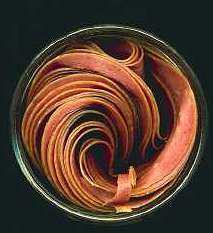
Meat preservation in general (of meat from livestock, game, and poultry) comprises the set of all treatment processes for preserving the backdrop, gustatory modality, texture, and color of raw, partially cooked, or cooked meats while keeping them edible and rubber to eat. Curing has been the dominant method of meat preservation for thousands of years, although modern developments like refrigeration and synthetic preservatives have begun to complement and supplant it.
While meat-preservation processes like curing were mainly developed in order to prevent illness and to increment food security, the advent of mod preservation methods mean that in nigh developed countries today[update], curing is instead mainly practised for its cultural value and desirable impact on the texture and taste of food. For bottom-developed countries, curing remains a key process in the production, transport and availability of meat.
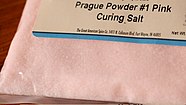
Some traditional cured meat (such as authentic Parma ham[two] and some authentic Spanish chorizo and Italian salami) is cured with salt lone.[3] Today, potassium nitrate (KNO3) and sodium nitrite (NaNO2) (in conjunction with salt) are the virtually common agents in curing meat, considering they bail to the myoglobin and human action every bit a substitute for oxygen,[4] thus turning myoglobin red.[iv] [5] More contempo evidence shows that these chemicals also inhibit the growth of the leaner that cause the disease botulism.[4] Yet, a 2018 written report by the British Meat Producers Clan adamant that legally permitted levels of nitrite accept no effect on the growth of the Clostridium botulinum bacteria which causes botulism, which in line with the UK'southward Advisory Commission on the Microbiological Safety of Food stance that nitrites are not required to forbid C. botulinum growth and extend shelf life.[6]
The combination of table salt with nitrates or nitrites, called curing salt, is frequently dyed pinkish to distinguish it from table table salt.[7] Neither table salt, nor any of the nitrites or nitrates commonly used in curing (eastward.chiliad., sodium nitrate [NaNO3],[8] sodium nitrite,[8] and potassium nitrate[9]) is naturally pinkish.
Necessity of curing [edit]
Meat decomposes rapidly if it is non preserved. The speed of decomposition depends on several factors, including ambient humidity, temperature, and the presence of pathogens. Most types of untreated meat cannot be kept at room temperature for lengthy periods before spoiling.[ citation needed ]
Spoiled meat changes color and exudes a foul olfactory property. Ingestion can cause serious food poisoning. Common salt-curing processes were developed in artifact[10] in social club to ensure food safety without relying on artificial anti-bacterial agents.
The brusk shelf life of fresh meat does not pose significant issues when access to it is easy and supply is abundant. Just in times of scarcity and famine, or when the meat must be transported over long distances, the usefulness of food preservation is obvious.
Curing significantly increases the length of fourth dimension meat remains edible, past making information technology inhospitable to the growth of microbes.
History [edit]
A survival technique since prehistory, the preservation of meat has become, over the centuries, a topic of political, economic, and social importance worldwide.
Traditional methods [edit]
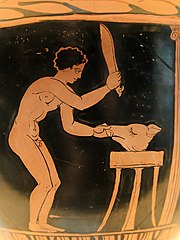
Food curing dates back to aboriginal times, both in the form of smoked meat and table salt-cured meat.[11]
Several sources draw the salting of meat in the ancient Mediterranean world. Diodore of Sicily in his Bibliotheca historica wrote that the Cosséens[12] in the mountains of Persia salted the flesh of carnivorous animals.[13] Strabo indicates that people at Borsippa were catching bats and salting them to consume.[xiv] The aboriginal Greeks prepared tarichos ( τάριχος ), which was meat and fish conserved by salt or other means.[a] The Romans called this dish salsamentum – which term later included salted fat, the sauces and spices used for its preparation.[15] Also evidence of ancient sausage product exists. The Roman gourmet Apicius speaks of a sausage-making technique involving œnogaros (a mixture of the fermented fish sauce garum with oil or wine).[16] Preserved meats were furthermore a part of religious traditions: resulting meat for offerings to the gods was salted before being given to priests, after which it could be picked up again by the offerer, or fifty-fifty sold in the butcher's.[15]
A merchandise in common salt meat occurred beyond aboriginal Europe. In Polybius's time (c. 200 – c.118 BCE),[17] the Gauls exported common salt pork each yr to Rome in large quantities, where it was sold in unlike cuts: rear cuts, middle cuts, hams, and sausages. This meat, later on having been salted with the greatest care, was sometimes smoked. These goods had to have been considerably important, since they fed office of the Roman people and the armies. The Belgae were celebrated above all for the care which they gave to the fattening of their pigs. Their herds of sheep and pigs were so many, they could provide skins and salt meat not simply for Rome, simply also for about of Italy.[ citation needed ] The Ceretani of Spain drew a big export income from their hams, which were so delicious, they were in no way junior to those of Cantabria. These tarichos of sus scrofa became especially sought, to the point that the ancients considered this meat the about nourishing of all and the easiest to digest.[xv]
In Ethiopia, according to Pliny,[18] [ clarification needed ] and in Great socialist people's libyan arab jamahiriya according to Saint Jerome, the Acridophages (literally, the locust-eaters) salted and smoked the crickets which arrived at their settlements in the spring in peachy swarms and which constituted, it was said, their sole food.
The smoking of meat was a traditional practice in N America, where Plains Indians hung their meat at the peak of their tipis to increment the amount of smoke coming into contact with the food.[11]
Middle Ages [edit]
In Europe, medieval cuisine made great utilize of meat and vegetables, and the guild of butchers was amidst the almost powerful. During the 12th century,[19] salt beef was consumed by all social classes. Smoked meat was called carbouclée in Romance tongues[20] and bacon if it was pork.[21]
The Middle Ages made pâté a masterpiece: that which is, in the 21st century, merely spiced minced meat (or fish), baked in a terrine and eaten cold, was at that fourth dimension composed of a dough envelope stuffed with varied meats and superbly busy for ceremonial feasts. The first French recipe, written in verse by Gace de La Bigne, mentions in the same pâté three bully partridges, 6 fatty quail, and a dozen larks. Le Ménagier de Paris mentions pâtés of fish, game, young rabbit, fresh venison, beef, dove, mutton, veal, and pork, and fifty-fifty pâtés of lark, turtledove, baby bird, goose, and hen. Bartolomeo Sacchi, called Platine, prefect of the Vatican Library, gives the recipe for a pâté of wild beasts: the mankind, later being boiled with salt and vinegar, was larded and placed within an envelope of spiced fat, with a mélange of pepper, cinnamon and pounded lard; ane studded the fat with cloves until it was entirely covered, then placed information technology within a pâte.
In the 16th century, the about fashionable pâtés were of woodcock, au bec doré, chapon, beef tongue, cow feet, sheep feet, chicken, veal, and venison.[22] In the same era, Pierre Belon notes that the inhabitants of Crete and Chios lightly salted then oven-stale unabridged hares, sheep, and roe deer cut into pieces, and that in Turkey, cattle and sheep, cut and minced rouelles, salted then dried, were eaten on voyages with onions and no other grooming.[23]
Early modern era [edit]
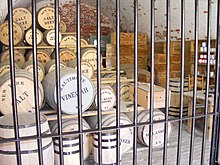
During the Age of Discovery, salt meat was i of the main foods for sailors on long voyages, for instance in the merchant marine or the navy. In the 18th century, salted Irish beefiness, transported in barrels, were considered finest.[24]
Scientific research on meat by chemists and pharmacists led to the creation of a new, extremely practical product: meat extract, which could announced in unlike forms. The need to properly feed soldiers during long campaigns outside the country, such as in the Napoleonic Wars, and to nourish a constantly growing population oft living in appalling conditions collection scientific inquiry, but a confectioner, Nicolas Appert, in 1795 developed through experimentation a method which became universal and in i language bears his name: airtight storage, chosen appertisation in French.
With the spread of appertisation, the 19th-century world entered the era of the "food industry", which developed new products such as canned common salt meat (for example corned beef). The desire for safer food led to the creation of the The states's Pure Food and Drug Human activity in 1906, followed by the national agencies for wellness security and the institution of food traceability over the course of the 20th century.[ citation needed ] It also led to continuing technological innovation.
In France, the summer of 1857 was and then hot that nearly butchers refused to slaughter animals and charcutiers lost considerable amounts of meat, due to inadequate conservation methods. A fellow member of the Academy of Medicine and his son issued a 34-page summary of works printed betwixt 1663 and 1857, which proposed some solutions: not less than 91 texts be, of which 64 edited for only the years between 1851 and 1857.[25]
Chemical actions [edit]
Common salt [edit]
Table salt (sodium chloride) is the main ingredient used in meat curing.[11] Removal of h2o and addition of salt to meat creates a solute-rich surround where osmotic pressure draws water out of microorganisms, slowing downwards their growth.[xi] [26] Doing this requires a concentration of table salt of nearly twenty%.[26] In improver, salt causes the soluble proteins to come to the surface of the meat that was used to make the sausages. These proteins coagulate when the sausage is heated, helping to agree the sausage together.[27]
Sugar [edit]
The sugar added to meat for the purpose of curing it comes in many forms, including honey, corn syrup solids, and maple syrup.[28] Yet, with the exception of bacon, it does not contribute much to the flavor,[29] just information technology does convalesce the harsh flavor of the salt.[11] Sugar too contributes to the growth of beneficial bacteria such every bit Lactobacillus past feeding them.[30]
Nitrates and nitrites [edit]
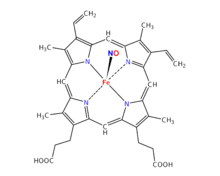
Nitrates and nitrites extend shelf life,[ citation needed ] assist kill bacteria, produce a characteristic flavor and give meat a pinkish or red color.[31] Nitrite (NO −
2 ) is generally supplied by sodium nitrite or (indirectly) past potassium nitrate. Nitrite salts are most often used to accelerate curing and impart a pinkish color.[32] Nitrate is specifically used merely in a few curing conditions and products where nitrite (which may exist generated from nitrate) must be generated in the product over long periods of time.
Nitrite further breaks down in the meat into nitric oxide (NO), which then binds to the iron atom in the heart of myoglobin's heme group, reducing oxidation and causing a reddish-brown colour (nitrosomyoglobin) when raw and the feature cooked-ham pink color (nitrosohemochrome or nitrosyl-heme) when cooked. The addition of ascorbate to cured meat reduces germination of nitrosamines (encounter beneath), but increases the nitrosylation of iron.
The utilise of nitrite and nitrate salts for meat in the Us has been formally used since 1925.[ commendation needed ] Because of the relatively loftier toxicity of nitrite (the lethal dose in humans is about 22 mg/kg of torso weight), the maximum allowed nitrite concentration in US meat products is 200 ppm. Plasma nitrite is reduced in persons with endothelial dysfunction.[33]
Nitrite-containing processed meat is associated with increased risk of developing colorectal cancer.[34] Adding nitrites to meat has been shown to generate known carcinogens such every bit nitrosamines, N-Nitrosamides[35] and nitrosyl-heme, resulting from nitrosylation reactions; the World Health System (WHO) advises that each 50 g (1.8 oz) of "processed meats" eaten a day would enhance the risk of getting bowel cancer past 18% over a lifetime; "processed meat" refers to meat that has been transformed through salting, curing, fermentation, smoking, or other processes to raise flavour or meliorate preservation. The World Wellness Organization'southward review of more than than 400 studies concluded, in 2015, that there was sufficient evidence that "candy meats" acquired cancer, especially colon cancer; the WHO'due south International Agency for Research on Cancer classified "processed meats" every bit carcinogenic to humans (Group 1).[32] [36]
The use of nitrites in food preservation is highly controversial[37] due to the potential for the formation of nitroso-compounds such as nitrosamines, North-Nitrosamides and nitrosyl-heme.[ citation needed ] When the meat is cooked at loftier temperatures, nitrite-cured meat products can also lead to the formation of nitrosamines.[31] [38] The event is seen for red processed meat, merely non for white meat or fish.[39] [40] Nitrates and nitrites may cause cancer and the production of carcinogenic nitrosamines tin can be potently inhibited by the employ of the antioxidants vitamin C and the alpha-tocopherol form of vitamin Eastward during curing.[41] Under simulated gastric atmospheric condition, nitrosothiols rather than nitrosamines are the principal nitroso species being formed.[39] The use of either compound is therefore regulated; for instance, in the United States, the concentration of nitrates and nitrites is generally limited to 200 ppm or lower.[31]
While the meat industry considers nitrites irreplaceable because they speed up curing and ameliorate color,[32] they take no issue on the growth of the bacteria which causes botulism:[32] an extremely rare illness (less than 1000 cases reported worldwide per year), and almost always associated with home preparations of food storing.[42] All Parma ham has been fabricated without nitrites since 1993, and was reported in 2018 to have caused no cases of botulism.[32]
Furthermore, while the FDA has set a limit of 200 ppm of nitrates for cured meat, they are non allowed and not recognized as safe in most other foods, even foods that are not cooked at high temperatures, such equally cheese.[43]
Nitrites from celery [edit]
Candy meats without "added nitrites" may exist misleading as they may be using naturally occurring nitrites from celery instead.[44]
A 2019 study from Consumer Reports [45] found that using celery (or other natural sources) as a curing amanuensis introduced naturally occurring nitrates and nitrites. The USDA allows the term "uncured" or "no nitrates or nitrites added" on products using these natural sources of nitrites, which provides the consumer a simulated sense of making a healthier choice. The Consumer Reports investigation also provides the average level of sodium, nitrates and nitrites found per gram of meat in their study.
Consumer Reports and the Eye for Scientific discipline in the Public Involvement filed a formal request to the USDA to modify the labeling requirements in 2019.[46]
Smoke [edit]
Meat can as well be preserved by "smoking". If the smoke is hot enough to slow-melt the meat, this volition also keep it tender.[47] One method of smoking calls for a smokehouse with damp wood chips or sawdust.[48] In North America, hardwoods such as hickory, mesquite, and maple are commonly used for smoking, as are the forest from fruit trees such as apple, cherry, and plum, and fifty-fifty corncobs.
Smoking helps seal the outer layer of the food being cured, making it more than difficult for bacteria to enter. It can exist done in combination with other curing methods such as salting. Common smoking styles include hot smoking, smoke roasting (pit barbecuing) and cold smoking. Smoke roasting and hot smoking cook the meat while cold smoking does not. If the meat is cold smoked, information technology should be dried quickly to limit bacterial growth during the critical period where the meat is not even so dry. This can be achieved, as with hasty, by slicing the meat thinly.
The smoking of nutrient directly with woods smoke is known to contaminate the nutrient with carcinogenic polycyclic effluvious hydrocarbons.[49]
Outcome of meat preservation [edit]
On wellness [edit]
Since the 20th century, with respect to the relationship betwixt diet and human affliction (e.m. cardiovascular, etc.), scientists have conducted studies on the effects of lipolysis on vacuum-packed or frozen meat. In item, by analyzing entrecôtes of frozen beef during 270 days at −20 °C (−4 °F), scientists plant an important phospholipase that accompanies the loss of some unsaturated fatty n-3 and n-6, which are already low in the mankind of ruminants.[50]
In 2015, the International Agency for Research on Cancer of the World Health Organization classified processed meat, that is, meat that has undergone salting, curing, fermenting, or smoking, as "carcinogenic to humans".[51] [52] [36]
On merchandise [edit]
The improvement of methods of meat preservation, and of the ways of transport of preserved products, has notably permitted the separation of areas of production and areas of consumption, which tin now be distant without information technology posing a trouble, permitting the exportation of meats.
For example, the appearance in the 1980s of preservation techniques under controlled atmosphere sparked a small revolution in the world'southward market for sheep meat: the lamb of New Zealand, one of the world's largest exporters of lamb, could henceforth exist sold as fresh meat, since it could be preserved from 12 to 16 weeks, which was a sufficient duration for it to reach Europe by boat. Before, meat from New Zealand was frozen, thus had a much lower value on European shelves. With the arrival of the new "chilled" meats, New Zealand could compete even more strongly with local producers of fresh meat.[53] The apply of controlled atmosphere to avert the depreciation which affects frozen meat is equally useful in other meat markets, such every bit that for pork, which at present also enjoys an international merchandise.[54]
Run into also [edit]
- Brining – Food processing past treating with brine or salt
- Ceviche – Dish of marinated raw seafood
- Charcuterie – Branch of cooking of prepared meat products, primarily from pork
- Cured fish – Fish subjected to fermentation, pickling or smoking
- Curing common salt
- List of dried foods
- List of smoked foods
- Sausage making – Sausage product processes
- Biltong – Form of dried, cured meat that originated in South Africa
Notes [edit]
- ^ In fourth dimension the original term came to hateful salted fish just, whereas salted meat was called kreas tarichēron ( κρέας ταριχηρὸν ), co-ordinate to Athenaeus of Naucratis in his Deipnosophistae, IV, 14.137f (en ligne)
References [edit]
- ^ a b "Historical Origins of Food Preservation." Academy of Georgia, National Center for Domicile Food Preservation. Accessed June 2011.
- ^ "Parma and Iberian hams, red from zinc". Curious Cook . Retrieved viii February 2019.
- ^ Coudray, Guillaume (2017). Cochonneries : comment la charcuterie est devenue un poison. Paris. ISBN9782707193582. OCLC 1011036745.
- ^ a b c Ulin, Don (10 May 2011). "Why Meat Stays Red: Myoglobin And Nitrites". A Moment of Scientific discipline - Indiana Public Media.
- ^ Schweihofer, Jeannine (21 October 2014). "Cured meat color: Part iii". MSU Extension.
- ^ Doward, Jamie (23 March 2019). "Revealed: no demand to add together cancer-chance nitrites to ham". The Observer. London. ISSN 0261-3077. Archived from the original on 26 January 2021. Retrieved xiv February 2021.
The results show that there is no modify in levels of inoculated C botulinum over the curing procedure, which implies that the action of nitrite during curing is non toxic to C botulinum spores at levels of 150ppm [parts per 1000000] ingoing nitrite and below.
- ^ Bitterman, 1000. (2010). "Salt Reference Guide". Salted: A Manifesto on the Globe's Most Essential Mineral, with Recipes. Random House. p. 187. ISBN978-1580082624 . Retrieved 16 August 2013.
- ^ a b Gisslen, W. (2006). "Sausages and Cured Foods". Professional Cooking, Higher Version. Hoboken, NJ: John Wiley & Sons. p. 827. ISBN9780471663744 . Retrieved sixteen August 2013.
- ^ "Meat Science", University of Wisconsin. uwex.edu.
- ^ "PROSCIUTTO DI PARMA PDO". Italian Made . Retrieved 8 Feb 2019.
- ^ a b c d e Ray, Frederick K. Oklahoma Cooperative Extension Service (PDF) (Report). Oklahoma State University. Retrieved 15 December 2010.
- ^ A nomadic shepherd people, considered past classical authors to exist made upwardly of warriors et de brigands, was the object of a victorious campaign by Alexander the Keen in the fourth century. Cf. Pierre Briant, État et pasteurs au Moyen-Orient ancien, Cambridge and Paris, 1982 (compte rendu).
- ^ Diodore de Sicile, Bibliothèque historique, XIX, xix cité par Koehler, 1832, p. 432, note 724 (p. 486).
- ^ Strabon, Géographie, Xvi, i.7.
- ^ a b c (in French) M. Koehler, Tarichos ou recherches sur l'histoire et les antiquités des pêcheries de la Russie méridionale, in Mémoires de l'Académie impériale des sciences de Saint-Pétersbourg, 6th series, book I, Imp. of the Académie impériale des sciences, Saint Petersburg, 1832, p. 347 à 490 (en ligne).
- ^ (in Latin) Apicii Coelii, De opsoniis et condimentis, sive arte coquinaria, libri decem. Cum annotationibus Martini Lister , Londres, 1705, livre Two, ch. 2, p. 59.
- ^ Cf. Joaquim Marquardt, La Vie privée des romains, 2, dans Manuel des antiquités romaines, xv, sous la dir. de Theodor Mommsen, Paris, 1893 [1874-1875], p. 52-56 et office. p. 54 (en ligne).
- ^ Pliny, Histoire naturelle, VI, 35.17
- ^ En Normandie par example : Léopold Delisle, Études historiques et archéologiques en province depuis 1848 cité dans la Revue des deux mondes, 11 (XXIe année), Paris, 1851, p. 1048.
- ^ Jean-Baptiste-Bonaventure de Roquefort, Supplément au glossaire de la langue romane, Chasseriau et Hécart, Paris, 1820, 308 pages
- ^ Jean Baptiste Bonaventure de Roquefort, Glossaire de la langue romane, T. I, B. Warée, Paris, 1808, 772 pages
- ^ Paul Lacroix et Ferdinand Séré, Le Moyen Âge et la Renaissance, histoire et description des mœurs et usages, du commerce et de l'industrie, des sciences, des arts, des littératures et des beaux-arts en Europe, T. I, ch. Nourriture et cuisine, Paris, 1848, non paginated.
- ^ Pierre Belon, Voyage au Levant, les observations de Pierre Belon du Mans, de plusieurs singularités et choses mémorables, trouvées en Grèce, Turquie, Judée, Égypte, Arabie et autres pays estranges, 1553.
- ^ Daniel Gilles et Guy Pessiot, Voiles en Seine 99. L'fleet du siècle, Ptc, 1999, ISBN 2906258547, p. 110.
- ^ (in French) A. Chevallier père et fils, Recherches chronologiques sur les moyens appliqués à la conservation des substances alimentaires de nature animale et de nature végétale, in Annales d'hygiène publique et de médecine légale, 2nd series, T. 8, J.-B. Baillière et fils, Paris, 1857, 480 pages, p. 291 – 324.
- ^ a b "Curing and Brining (food preservation)" (PDF). Scientific discipline of Cooking. Minnesota State University. Retrieved 15 December 2010.
- ^ "Curing & Smoking". National Middle for Home Food Preservation. University of Georgia. Archived from the original on 30 May 2010. Retrieved 15 December 2010.
- ^ "Additives Used in Meat". Meat Science. Illinois State Academy. Archived from the original on 2 May 2010. Retrieved 16 December 2010.
- ^ "Smoking and Curing". The National Centre for Home Food Preservation. University of Georgia. Retrieved 16 December 2010.
- ^ "What Is Curing?". Scientific discipline of Cooking. EDinformatics. Retrieved xvi December 2010.
- ^ a b c "Curing Food". Edinformatics. Retrieved 21 February 2010.
- ^ a b c d due east Wilson, Bee (1 March 2018). "Yes, bacon really is killing us". The Guardian. London. Archived from the original on x February 2021. Retrieved 14 February 2021.
In trade journals of the 1960s, the firms who sold nitrite powders to ham-makers spoke quite openly about how the main advantage was to increase profit margins by speeding upwardly production.
- ^ Kleinbongard P, Dejam A, Lauer T, Jax T, Kerber S, Gharini P, Balzer J, Zotz RB, Scharf RE, Willers R, Schechter AN, Feelisch K, Kelm Thousand (2006). "Plasma nitrite concentrations reflect the degree of endothelial dysfunction in humans". Complimentary Radical Biological science and Medicine. 40 (2): 295–302. doi:ten.1016/j.freeradbiomed.2005.08.025. PMID 16413411.
- ^ Crowe, William; Elliott, Christopher T.; Green, Brian D. (5 November 2019). "A Review of the In Vivo Bear witness Investigating the Part of Nitrite Exposure from Candy Meat Consumption in the Evolution of Colorectal Cancer". Nutrients. 11 (11): 2673. doi:x.3390/nu11112673. PMC6893523. PMID 31694233.
- ^ Inoue-Choi, Maki; Sinha, Rashmi; Gierach, Gretchen L.; Ward, Mary H. (ane April 2016). "Carmine and processed meat, nitrite, and heme iron intakes and postmenopausal breast cancer run a risk in the NIH-AARP Diet and Wellness Study". International Journal of Cancer. 138 (seven): 1609–1618. doi:ten.1002/ijc.29901. PMC4724256. PMID 26505173.
- ^ a b "IARC Monographs evaluate consumption of ruby-red meat and processed meat" (PDF). International Agency for Research on Cancer. 26 October 2015. Archived from the original (PDF) on xviii January 2021. Retrieved 14 February 2021.
Processed meat was classified equally carcinogenic to humans (Group one), based on sufficient evidence in humans that the consumption of processed meat causes colorectal cancer.
- ^ "Why is our meat still existence poisoned by nitrates?".
- ^ Flores, Mónica; Mora, Leticia; Reig, Milagro; Toldrá, Fidel (ane September 2019). "Chance cess of chemical substances of safety concern generated in processed meats". Nutrient Science and Human Health. 8 (3): 244–251. doi:ten.1016/j.fshw.2019.07.003.
- ^ a b Kuhnle, Yard.Yard.C.; Bingham, S.A. (1 Nov 2007). "Dietary meat, endogenous nitrosation and colorectal cancer". Biochemical Gild Transactions. 35 (five): 1355–1357. doi:10.1042/BST0351355. PMID 17956350. S2CID 29766026.
- ^ Bingham, Sheila Anne; Hughes, Roisin; Cross, Amanda Jane (1 Nov 2002). "Effect of White Versus Red Meat on Endogenous N-Nitrosation in the Man Colon and Further Testify of a Dose Response". The Periodical of Nutrition. 132 (11): 3522S–3525S. doi:x.1093/jn/132.11.3522S. PMID 12421881.
- ^ Parthasarathy, Deepa Thousand.; Bryan, Nathan S. (November 2012). "Sodium nitrite: The 'cure' for nitric oxide insufficiency". Meat Science. 92 (iii): 274–279. doi:10.1016/j.meatsci.2012.03.001. PMID 22464105.
- ^ "Botulism". Centers for Illness Control and Prevention . Retrieved 30 September 2018.
- ^ "Import Alert 12-12". U.Southward. Food & Drug Administration . Retrieved thirty September 2018.
- ^ Choi, Candice (xxx June 2017). "Experts say hot dogs minus artificial nitrites may be no improve". Chicago Tribune . Retrieved 2 Oct 2018.
- ^ Calvo, Trisha (29 Baronial 2019). "Danger at the Cafeteria". Consumer Reports . Retrieved 31 August 2019.
- ^ Aubrey, Allison (29 August 2019). "Duped In The Cafeteria Alley? 'No Nitrates Added' Labels Are Oftentimes Misleading". NPR . Retrieved 31 August 2019.
- ^ "Smoking Meat and Poultry". Fact Sheets. United states of america Department of Agriculture. Archived from the original on 17 October 2010. Retrieved 27 January 2011.
- ^ Busboom, Jan R. "Curing and Smoking Poultry Meat" (PDF). Washington Land University. Archived from the original (PDF) on 20 July 2011. Retrieved 27 Jan 2011.
- ^ Fritz, West.; Soós, Thou. (1980). "Smoked Food and Cancer". Foreign Substances and Nutrition. Forum of Nutrition. Vol. 29. pp. 57–64. doi:10.1159/000387467. ISBN978-iii-8055-0621-2. PMID 7447916.
- ^ Bauchart, Dominique; Thomas, E.; Scislowski, V.; Peyron, Alain; Durand, Denys (iv October 2006). "Effets des modes de conservation de la viande bovine sur les lipides et leur contenu en acides gras polyinsaturés" [Effects of beef preservation methods on lipids and their polyunsaturated fatty acid content]. Journées Sciences du Muscle et Technologies des Viandes (in French). Hors-Série. INIST:18356301.
- ^ Stacy Simon (26 October 2015). "Earth Health Organization Says Processed Meat Causes Cancer". Cancer.org.
- ^ Gallagher, James (26 October 2015). "Processed meats practice cause cancer - WHO". BBC News.
- ^ "Les marchés à fifty'importation" (PDF). 2004. Archived from the original (PDF) on 22 September 2016. Retrieved 21 July 2010.
- ^ Trégaro, Yves (2003). "Exportations françaises de viande de porc et stratégies des opérateurs nationaux" [French exports of pigmeat and strategies of national operators] (PDF). Journées de la recherche porcine (in French). 35: 217–222.
Bibliography [edit]
- This commodity was partially translated from the French Wikipedia.
- McGee, Harold. On Nutrient and Cooking (revised). New York, NY: Scribner, 2004. ISBN 0-684-80001-2
- Coudray, Guillaume. Who poisoned your bacon. London: Icon Books, 2021. ISBN ix-781-78578612-9, 9-781-78578786-7
- Bertolli, Paul. Cooking by Manus. New York, NY: Clarkson Potter/Publishers, 2003. ISBN 0-609-60893-ii
- National Research Quango University of Life Sciences. "The Wellness Furnishings of Nitrate, Nitrite and N-Nitroso Compounds". Washington DC: National Academy Printing, 1981.
- Commodity in The Scientist, Book xiii, No. 6:1, Mar. xv, 1999 (registration required). [ dead link ]
- Post on April 29, 2012 "Making Cured Meats"
External links [edit]
| | Look up cure in Wiktionary, the free dictionary. |
- National Center for Home Food Preservation - Curing Foods
- National Eye for Domicile Food Preservation - How Do I? Curing and Smoking
quezadasumpeormses92.blogspot.com
Source: https://en.wikipedia.org/wiki/Curing_(food_preservation)
0 Response to "2 Barrels of Bacon Case of Salted Dried Beef"
Enregistrer un commentaire